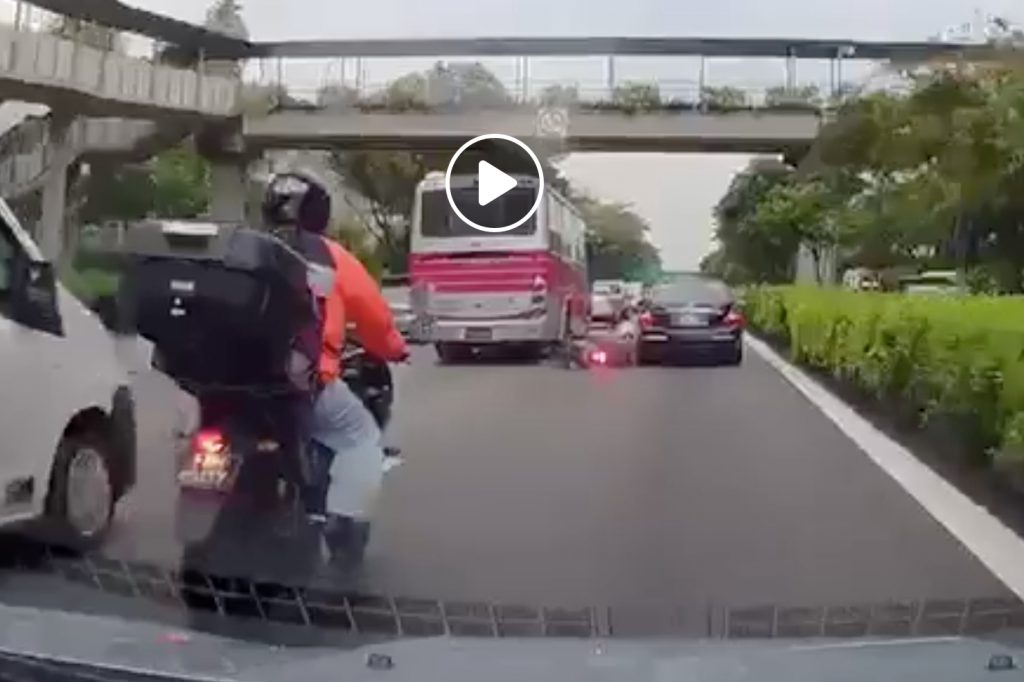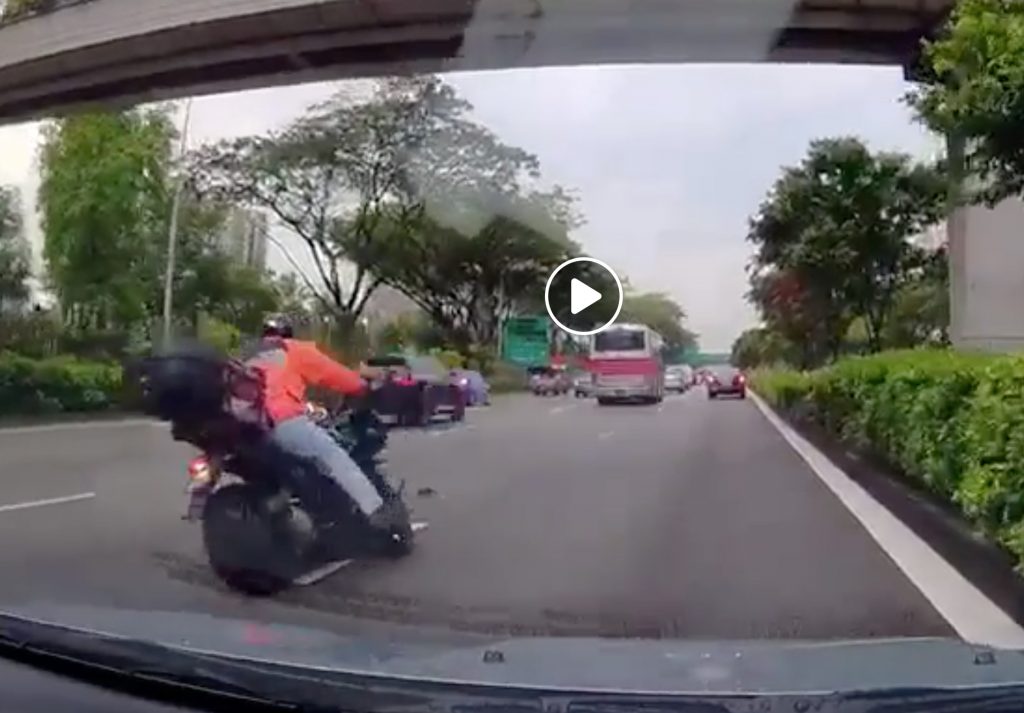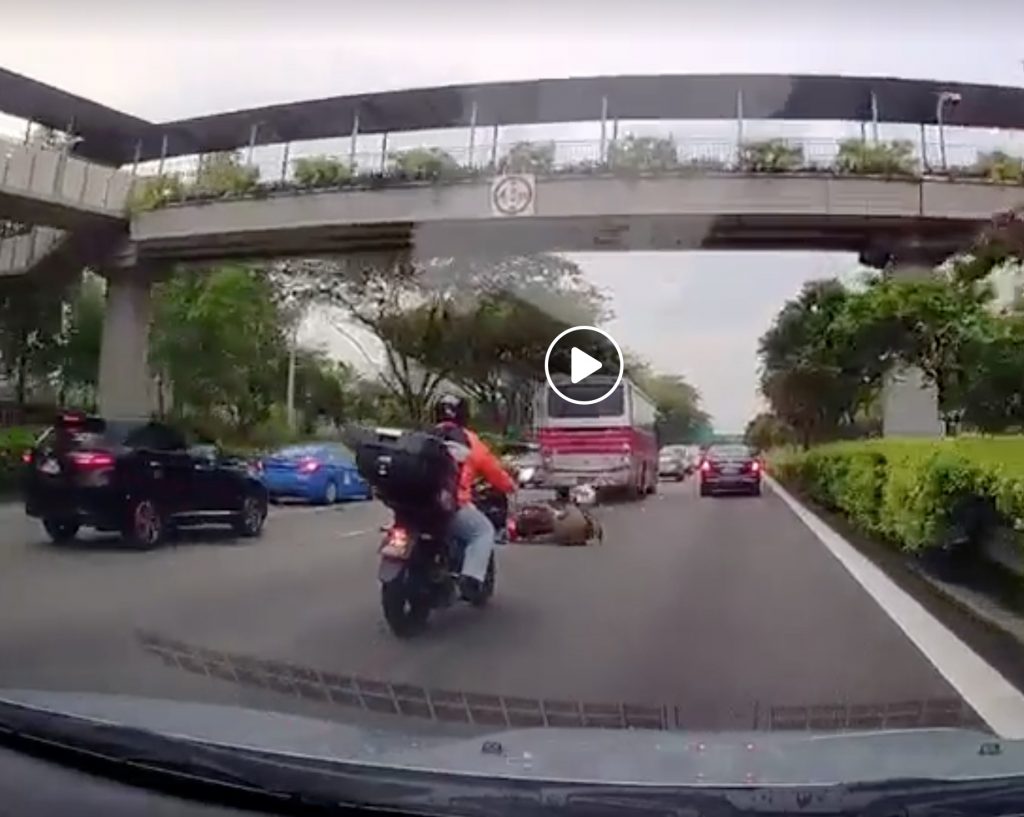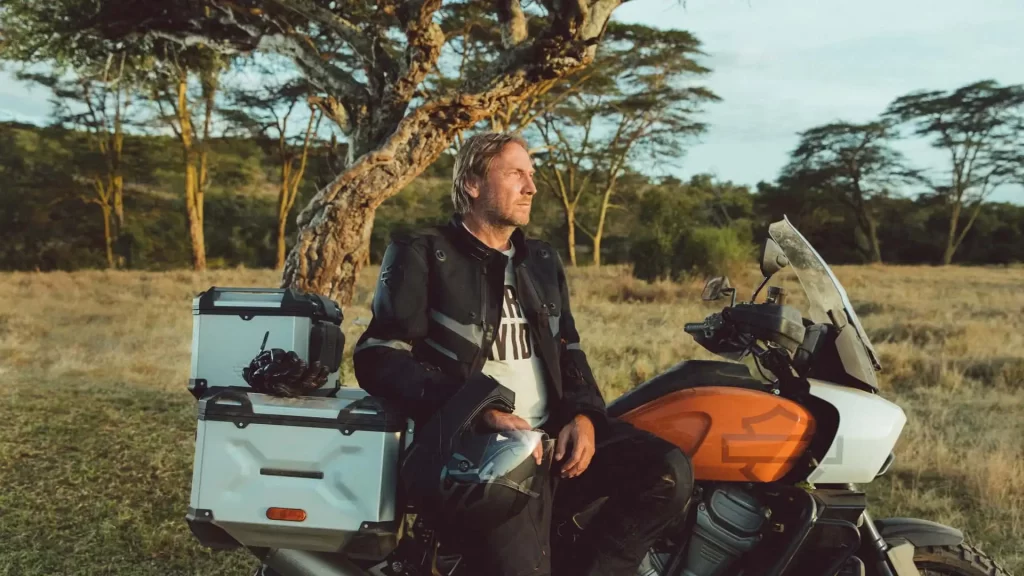-
As we’ve posted before, accident videos can help us learn.
-
In this video, two bikes crashed together through improper braking and target fixation.
-
We’re not criticizing anyone, but here are tips on how to avoid such tragedy.
A Singaporean Facebook page shared a video of an accident involving two motorcycles this morning. But rather than just condemning the parties involved we could perhaps learn that target fixation and improper braking is dangerous for us motorcyclists.
We are not trying to be experts here either. But after years of practice and riding in the same situation at least three times per trip per day, one tends to learn.
Watch the video below:
Part 1 – First rider
First rider panicked as he was trying to slip between the bus and car. He grabbed his front brake with full power, resulting in the front tyre washing out.
First lesson: Overtaking
- If you need to overtake, do it quickly to get out of the “sandwich zone.”
- But don’t ride more than 40 km/h faster than the vehicles around you.
- Too fast and you won’t have time to react.
- We humans normally take 0.5 second to react.
- A vehicle covers 13.8 metres in 0.5 second at 50 km/h, and 27.7 metres in 1 second at 100 km/h. You decide.

What if he didn’t overtake?
- Better to just follow the car if you’re not confident enough of overtaking.
- The best place to follow is NOT directly behind, but to the side where there’s a good chance of the driver picking you up in the rearview mirror.
- Additionally, it gives you room to avoid the car should he brake suddenly.
How should we brake?
- Never, ever grab your front brake lever full-on.
- Always increase the braking pressure progressively even when under threat.
- Applying the front brake progressively allows the front suspension and tyre to soak up the weight transfer progressively, as well.
- Jamming on the brake, on the other hand, transfers weight abruptly, causing the weight transfer to overwhelm the suspension and tyre.
Solution:
We know it’s easier than it sounds, but every motorcyclist should practice emergency braking. And we’re not talking about dragging the locked rear wheel like in JPJ tests!
- Find yourself a large and empty parking lot.
- Ride to 30 km/h and pull in the front brake lever progressively harder and harder until the bike stops.
- Increase the speed you being to brake from gradually if you feel confident enough.
- If you always ride at 150 km/h, we suggest you practice stopping from that speed – a lot.
Would ABS have helped?
It may but the first bike looked like a kapchai/scooter, hence it probably isn’t equipped with ABS. Even then, the best way is to ease up on the pressure at the lever to let the bike’s momentum stabilize itself. This can be helped through practice.
But what if there’s ABS?
- It doesn’t mean one can get away with crashing even if there’s ABS.
- We must first learn how it feels like when ABS activates.
- The lever will pulsate when ABS activates, surprising some riders to let go of the lever too abruptly and the system stops functioning.
- Secondly, ABS keeps the previously locked wheel rolling in order to provide the chance of swerving away from danger. However, this is always defeated by target fixation (refer part 2 below).
- Thirdly, ABS can cause some riders to keep holding on to the brake lever will full power until the bike stops dead. The rider will then lose balance and topple over (jatuh bodoh).
- So, if the ABS activates, keep braking until you scrub off enough speed for you to still retain control of the bike and maneuver. But let go of the brakes progressively.
Part 2 – The following rider
The following rider saw the crashed bike ahead and applied his brakes a fraction later. Remember? A human’s nominal reaction time is 0.5 second. He kept braking but still ran into the poor man on the road.
What went wrong?
- First and foremost (remember these words): Target fixation.
- Keep in mind that the motorcycle goes where you look.
- In this case, he was looking directly at the first rider (he didn’t turn his head at all).

What is target fixation?
- Target fixation is a subconscious human instinct which instructs us to keep our eyes on a dangerous situation.
- Yes, it helped us to survive through almost a million years, but it doesn’t agree when you’re riding or handling any vehicle at speed.
- Being fixated on the first rider, he jumped on the brakes in panic, his body tenses up, his arms went straight.
- Now he has no way of steering the bike even with the ABS on (see the front pogos up and down).
What should have been his response?
- He should’ve looked to either side of the crashed rider ahead.
- Both vehicles on either side have slowed down, leaving both lanes empty.
- So, he could’ve swerved to avoid the fallen rider and apply some gas to get away, even without needing to slow down.
- Situational awareness helps here, consequently he would know if either side were clear without needing too look.
- Not tense up and lock his arms. Having relaxed arms allows the rider to steer even during hard braking. See how the MotoGP riders do it even when they’re braking from 330 km/h to 80 km/h to make a corner?

What are the solutions to target fixation?
- Overcoming target fixation needs practice.
- Next time you come across a pothole, look to either sides and steer.
- You’ll be surprised at how easy that was.
- Keep practicing when traffic is clear.
- You can even ride up to an imaginary hazard on the road, look to the sides and steer.
- This practice will suppress your instinct to target fixate.
What are the solutions to braking hard and still being able to steer?
- On braking and body position, do recall that fuel tanks have knee cutouts for a reason.
- Hence, clamp your knees on the tank to support yourself and take the pressure off your arms and torso.
- This way, you can brake much harder and have a better feel of the suspension and tyres’ limits.
- Please refer above about brake practice.
Conclusion
Every rider needs to be critical about his/her own riding skills and learn. It’s far better than relying on others to give way.
Oh, and look up videos or articles on riding tips. It’s time and energy well spent rather than be like keyboard warriors who only know how to criticize.
Video source: Xianghui Chaw on ROADS.sg

















